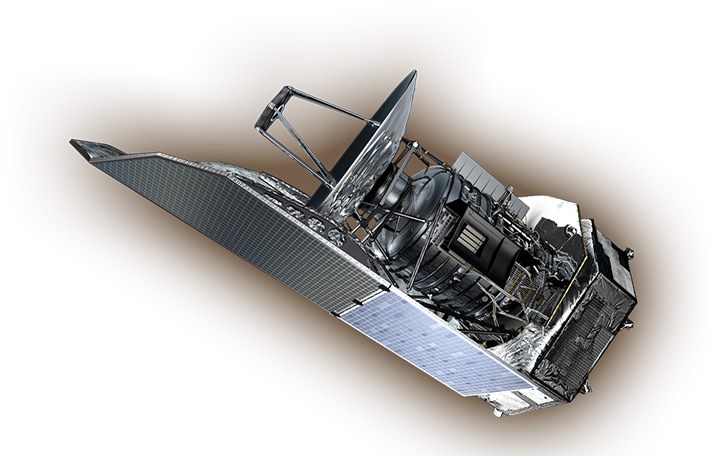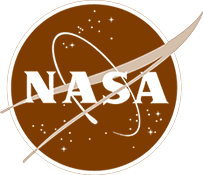Solar System
The Herschel Space Observatory will focus on Mars, the four giant planets, and the two homes of comets to uncover new information about them and about the nebula from which our solar system formed.
Comets
When Jupiter, Saturn, Uranus, and Neptune condensed out of the solar system's parent nebula some 4.6 billion years ago, there were millions of bits and pieces left over - the comets.
A region of comets lying beyond Neptune's orbit has remained fairly undisturbed since then. It is known as the Kuiper Belt, and it's the source of short-period comets like Halley.
But theory holds that the comets scattered among the giant planets were relocated - drawn to and then flung away by the planets' gravitational pull. (NASA has made good use of this "slingshot effect" to give spacecraft a boost on their way to the outer planets.)
Some of the comets are thought to have headed sunward and collided with the inner planets. In fact, one school of thought has it that these comets provided the water for Earth's oceans, and may also have contributed the complex organic molecules that led to life.
But most of the comets were thrown much farther. Massive Jupiter hurled most of the comets in its vicinity clear out of the solar system. The smaller giants propelled their comets with less force, and fewer gained the velocity needed to leave the solar system. The comets that didn't quite escape wound up forming the Oort Cloud, a vast storehouse of comets at the outskirts of the solar system, trillions of miles from the sun (compared to Pluto's average distance of less than 6 billion miles).
Since they have undergone little change since the beginning of the solar system, comets are thought to contain fairly pristine samples of the materials that formed the primordial nebula. So studying them is a good way to glimpse the original cloud of gas and dust from which the Sun and planets formed.
Herschel will make detailed observations of comets to help scientists reconstruct the early development of the solar system, and also determine whether comets were the source of water and pre-life chemicals on primitive Earth. (And if on Earth, then also perhaps on Mars and moons of the giant planets?)
Herschel will inventory comets' chemical composition, and study their physical and chemical processes. Comparing Kuiper Belt comets with those in the Oort Cloud will enable scientists to infer conditions in the different parts of the nebula where they formed.
The Deuterium/Hydrogen Ratio
One measurement of particular interest is the ratio of deuterium to hydrogen (D/H ratio) in cometary water.
Hydrogen is the simplest atom, with one electron in orbit around a nucleus of one proton. Deuterium is an isotope of hydrogen, in which the nucleus also has one neutron. Chemical compounds that contain hydrogen also come in versions made with deuterium.
Water that contains deuterium is known as "heavy water." Earth's oceans contain a characteristic percentage of heavy water. So do comets, which are mostly water, and some of the other planets and moons.
Knowing the D/H ratio of water and other substances is useful to scientists for two basic reasons.
First, it acts as a fingerprint. By comparing the D/H ratios in Earth's water with that in cometary water, for example, scientists can determine whether our planet's water could have come from comets. The same determination can be made for other planets and moons in the solar system.
Second, the D/H ratio in comets provides a clue to conditions at the beginning of the Universe!
Scientists think the D/H ratio of pristine comets represents that of our original nebula, which in turn is typical of the rest of the Universe. And all of the hydrogen and deuterium in the Universe is thought to have formed during the first three minutes after the Big Bang (the nuclei, that is - stable atoms didn't develop for another 300,000 years or so), so the D/H ratio of the Universe was fixed in place at that time.
Knowing that ultimate D/H ratio would help scientists determine the conditions that could have generated hydrogen and deuterium in that particular ratio, and therefore help them deduce the nature of the Universe in its earliest stages.
Giant Planets
Scientists are also interested in comparing the D/H ratios in the atmospheres of the four giant planets, and Herschel will measure them as well.
One important reason is to test a prevailing theory of planet formation. Scientists think that as our solar system developed, Jupiter and Saturn formed mostly from gas, while Uranus and Neptune - out in the more tenuous suburbs of the primordial nebula - formed from a much higher percentage of ice-covered dust grains.
If that is correct, then Uranus and Neptune should have a higher D/H ratio than Jupiter and Saturn, since icy dust mantles tend to have a higher ratio than the surrounding gas.
Comparing the ratios in the two pairs of planets will reveal information about the composition of that icy dust. And comparing them with the ratios in comets will further enhance our understanding of how all those bodies formed, and the structure of the primordial nebula.
The Infrared Space Observatory (ISO) surprised scientists when it detected water in the high atmospheres of the four giants. Herschel will help to determine whether that water came from their rings and moons or from the icy crusts of interplanetary dust.
Tracking water and other molecules at various altitudes (the "vertical profiles") provides information on how those atmospheres work - how convection moves gases up and down, and how winds blow them around.
Herschel will study the vertical mixing profiles of many molecules in the atmospheres of the giant planets, providing new insights about the chemistry and dynamics of the atmospheric layers. Ammonia and phosphine, which are affected by condensation, photochemical processes, and vertical transport, are expected to be among the most valuable guides to information about atmospheric circulation in the giant planets.
Herschel will map the spectral continuum of Jupiter and Saturn in the far-infrared for the first time to reveal properties of their clouds, especially particle size and density.
Looking further out to Uranus and Neptune, Herschel will measure the methane in their stratospheres.
Herschel will also search all four gas giants for chemicals never before seen in planetary atmospheres.
Mars
Understanding the atmospheric chemistry of Mars is important both for an understanding of Mars' history - including the possibility that it was more like Earth in its earlier days - and as a tool for comparing how atmospheres differ on different planets. Such studies may provide insights into the workings and possible future of our own atmosphere here on Earth.
Herschel will explore the Martian atmosphere in the 200-670 micron range for the first time, enabling scientists to determine the vertical profiles of water vapor and oxygen molecules. Monitoring water at various times during the Martian year will reveal seasonal changes.
It will also measure deuterium and carbon monoxide, and may detect other compounds, such as hydrogen peroxide, that are predicted by models of Martian photochemistry.
Finally, Herschel will obtain information about the composition and emissivity of minerals covering Mars' surface.







